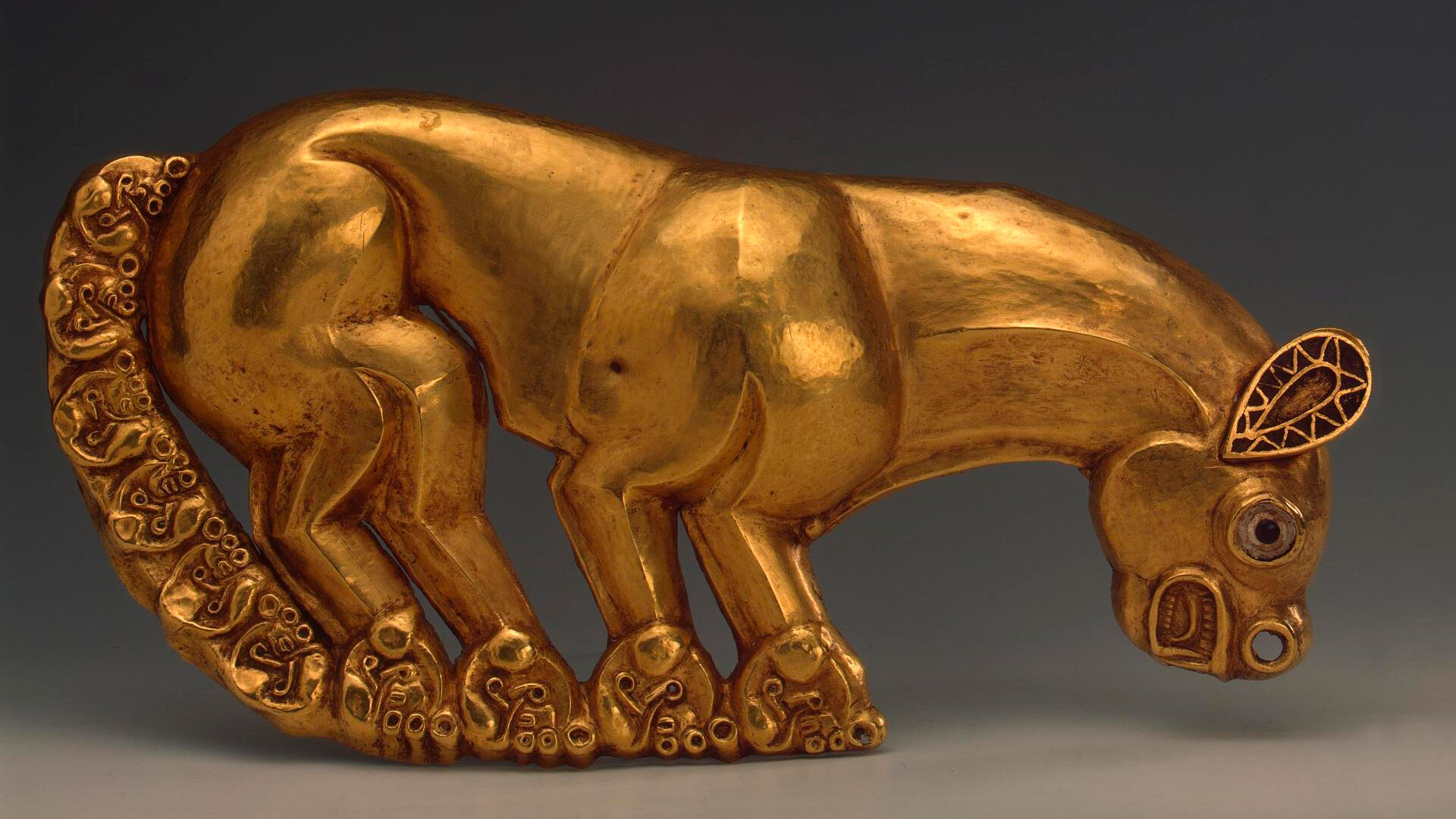
A virtual tour of the ‘Gold Room’
This large golden buckle in the shape of a stag decorated a ‘gorytos’ – a case for bow and arrows of a Scythian warrior. This artifact - a classic example of the Scythian animalistic style – was found in 1897 at the excavations in Zakubanye, near the Kostromskaya stanitsa (modern Krasnodar Territory), 77 kilometers away from Maikop (the Republic of Adygea).
The ‘Kostromskaya Stag’ is one of the symbols of the Hermitage. It also adorns the livery of one of Rossiya Airlines’ passenger planes.

Rossiya Airlines aircraft
Rossiya Airlines press departmentThis massive golden plate in the shape of a panther also adorned a case for bow and arrows. It was discovered in 1903 during the excavations in the ‘Kelermes kurgan’ (on the territory of the modern Republic of Adygea).
A ‘kurgan’ for ancient nomadic peoples was a ritual model of the world and was a part of the cult of the ancestors – patrons and intermediaries when conversing with the gods. Scythians believed that an artifact with a depiction of a predator would protect its owner from danger in the afterlife. The gold, from which this item is made, speaks of the high status of the buried.
This elegant item was made by a Greek jeweler on a Scythian commission. The comb, reminiscent of a pediment of a Greek temple, depicts a scene of battle between three warriors.
The ‘Solokha kurgan’, where the artifact was discovered, was established by scientists to be a burial place of a Scythian king and his brother. Delicately crafted details allowed historians to make assumptions about specific historical personalities of Scythia and their struggle for power.
This massive embossed golden plate was discovered at the excavations of the ‘Chertomlyk kurgan’ – the burial place of Scythian kings. They were buried along with their wives and concubines, cupbearers and servants, confidant warriors and stablemen, horses and dogs, as well as with clothing, weapons and many valuables.
The ‘gorytos’ features the story of Achilles, the hero of Homer’s poem ‘The Iliad’ and a character of Ancient Greek mythology, from his childhood to his death. This plaque, created by a Greek craftsman, could be a present to a Scythian chieftain from the ruler of the Bosporan Kingdom. It united Greek colony cities and existed on the territory of the Crimean Peninsula and the Taman Peninsula from the 5th century B.C. to the 6th century A.D.
This artifact was discovered in 1830 at the excavations of a kurgan on the Crimean Peninsula, not far from the city of Kerch (the former Greek city of Pantikapaion – the capital of the Bosporan Kingdom).
These pendants were also made by a Greek craftsman for a Scythian client. They depict the head of goddess Athena, which was popular in the region of the Northern Pontic Zone.
The prototype for it was the statue of Athena Parthenos (5th century B.C.) by sculptor Phidias. The 13-meter-tall statue from gold and ivory, which didn’t survive to our day, adorned Parthenon – the main temple of the goddess in Athens.
Scythian symbology is incorporated into the decoration of small Athena’s helm on the pendants. The image of the warrior goddess was close to the mentality of Scythian nomads. Before marriage, their women would participate in military action.
In 1864, during the construction of a pipeline on the outskirts of Novocherkassk (modern Rostov Region), a rich female burial site was uncovered – a ‘kurgan’ known as ‘Khokhlach’. The woman buried there, perhaps, was a Sarmatian priestess and queen. The Sarmatians were the neighbors of the Scythians; they pushed them out of the Northern Pontic Zone.
The main valuable from the burial site was a ‘calathus’ – a diadem of a priestess of the Sarmatian deity of fertility. Sacrificial animals, reflecting the mythological beliefs of the Sarmatians, walk towards the tree of life, are depicted on the ‘calathus’. The shape of the diadem, the female cameo bust made of quartz in the middle and hanging decorations belong to the tradition of Antiquity. Perhaps, the ‘calathus’ was made by a jeweler from the Bosporan Kindgom, who knew Sarmatian traditions well.
In 1864, in Prikubanye on the Taman Peninsula, the ‘Bolshaya Bliznitsa kurgan’ was opened, where, allegedly, the priestesses of the Bosporan Kingdom were buried.
A masterful ‘calathus’ was among the findings – a basket-shaped headdress, an attribute of the goddess of fertility. It depicts the Arimaspi – a mythical people, who, according to legend, lived in the northeast of the Ancient World (presumably near the modern Ural Mountains) - fighting griffins.
In 1739, Persian ruler Nader Shah conquered the city of Delhi, the capital of the Mughal Empire, which existed on the territory of modern India, Pakistan, Bangladesh and Afghanistan from the 16th to the 19th century. He brought so many riches from Delhi that he stopped collecting taxes in Persia for three years.
In 1741, he sent 20 of the captured items to St. Petersburg as a diplomatic gift. These gifts were brought from Persia over the course of two years on 14 elephants.
The exposition exhibits several vessels, a cup, a tray, plates, headdress decorations – aigrettes – and an anklet. These golden items are studded with uncut emeralds, rubies, diamonds and pearls.
Nader Shah brought a large amount of gems from Delhi, which were not mined in Iran. This contributed to the tradition of lavishly adorning Persian cold weapons with gems.
The Hermitage collection has a saber from bulat steel, the scabbard and hilt of which are decorated with gold and enamel, emeralds, spinels and diamonds.
The 59-centimeter-long scepter from golden filigree and giant white cut jades with a silk tassel served as a symbol of authority and of wish granting.
In 1895, the representatives of the Chinese Qing Empire presented it as a gift to Tsesarevich Nicholas Alexandrovich, future Emperor Nicholas II, as a wish for all his plans to come true.
Dear readers,
Our website and social media accounts are under threat of being restricted or banned, due to the current circumstances. So, to keep up with our latest content, simply do the following:
If using any of Russia Beyond's content, partly or in full, always provide an active hyperlink to the original material.
Subscribe
to our newsletter!
Get the week's best stories straight to your inbox